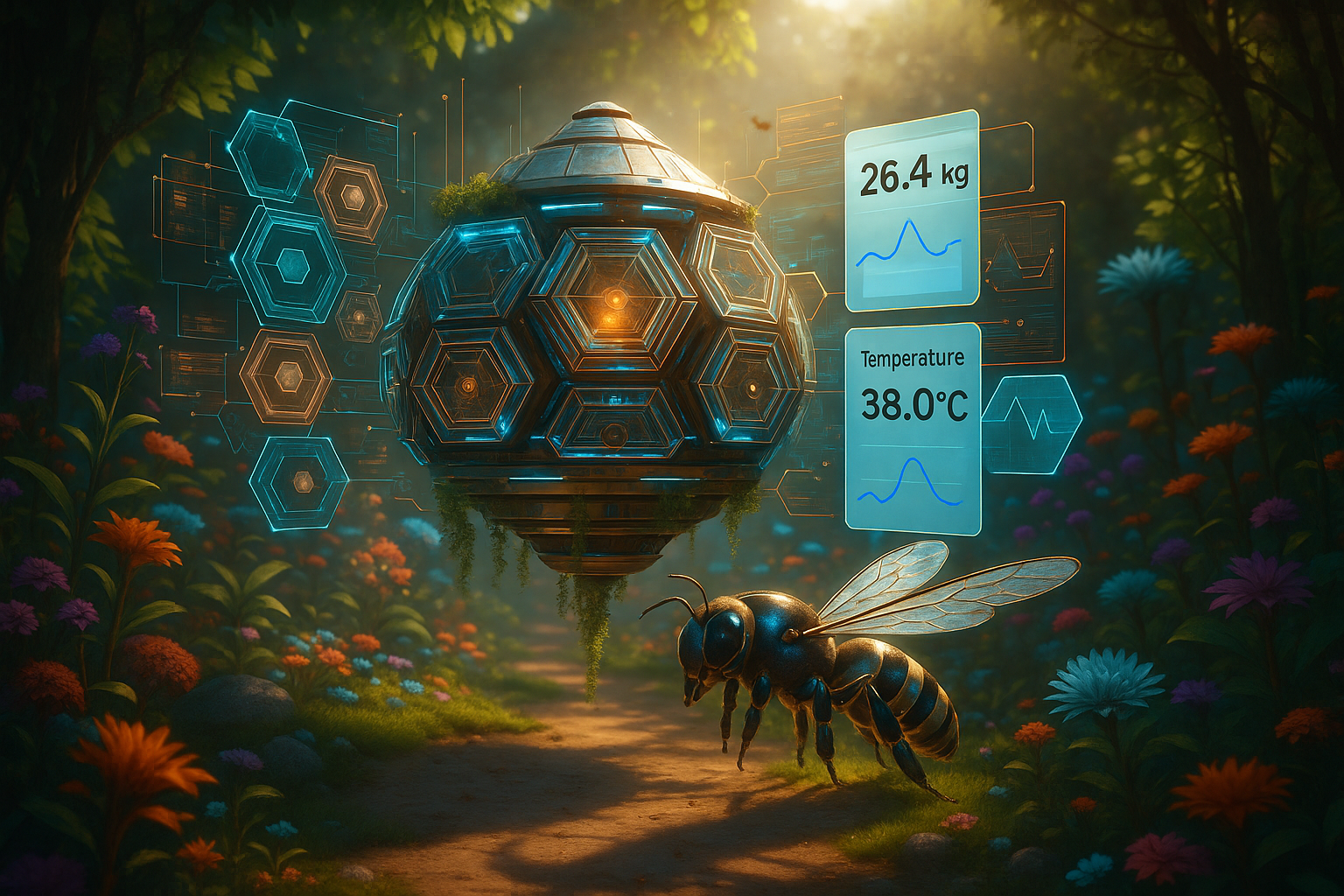- Tokyo: 18:38
- Singapore: 17:38
- Dubai: 13:38
- London: 09:38
- New York: 04:38
AI in Beekeeping: How Smart Tech is Transforming Honey Production
- Reading Time: 2 minutes, 43 seconds
- Post Views: 1327
Beekeeping is an ancient practice that now meets modern technology. Artificial intelligence applied to apiculture uses data, sensors, and algorithms to improve hive health, boost honey yield, and help beekeepers make timely, science-backed decisions. This encyclopedia entry explains core concepts, common tools, practical applications, benefits, limitations, and a short implementation guide for beekeepers interested in adding AI to their apiary.
Why beekeeping needs smarter tools
Bees face multiple stressors: parasites such as Varroa mites, pathogens, pesticides, habitat loss, and variable weather patterns. Small problems can escalate quickly, causing colony decline or swarming. Traditional inspection methods rely on periodic manual checks that are labor intensive and can disturb colonies. Scaling modern apiculture requires continuous monitoring and predictive insights so problems are detected early and interventions are targeted and minimally invasive.
What does AI in beekeeping mean?
AI in beekeeping refers to systems that collect data from hives and surrounding environments, then analyze that data with machine learning models and rule-based logic to provide actionable outputs. Data sources commonly include temperature and humidity sensors, weight scales, acoustic microphones, cameras, and GPS or weather feeds. The AI layer processes patterns — for example acoustic signatures that correlate with queenlessness, or weight changes that indicate nectar flow — and presents predictions or alerts to the beekeeper.
Core technologies and sensors
Temperature and humidity sensors: track internal hive microclimate, which is critical for brood development.
Weight scales: ongoing weight data reveals foraging intensity, nectar inflow, and honey harvest readiness.
Acoustic sensors: vibration and sound analysis can indicate queenlessness, swarming preparation, or abnormal colony stress.
Cameras and computer vision: image analysis helps estimate adult bee population, detect pests, or monitor entrance activity.
Gas sensors and brood frame imaging: detect changes associated with disease or brood abnormalities.
Edge devices and connectivity: local processors filter data and use lightweight models to reduce bandwidth needs before sending summaries to the cloud.
Cloud platforms and machine learning: aggregate data across hives and apiaries to build robust predictive models, derive seasonal baselines, and provide dashboards.
Practical applications
Hive health monitoring
Continuous sensor data allows detection of anomalies before visible signs appear. For example, sudden changes in acoustic patterns or internal temperature that differ from seasonal norms can trigger alerts to inspect for pests or disease.
Swarm prediction and prevention
AI models trained on historical hive activity and environmental factors can predict increased swarm risk, enabling preventive measures such as splitting hives or modifying frames.
Queen and brood monitoring
Computer vision and acoustic signatures can help detect problems with the queen or irregular brood patterns, reducing the need for disruptive manual inspections.
Foraging and nectar flow optimization
Weight data combined with weather and floral bloom forecasts helps beekeepers time supplemental feeding, supering, and harvests more precisely.
Varroa and disease management
Early detection models can flag conditions associated with Varroa infestation or viral outbreaks and recommend targeted treatments.
Quality control and traceability
Sensors and data logs create provenance records for honey quality, storage conditions, and harvest dates, supporting higher-value labeling and transparent supply chains.
Automation and robotics
Robotic tools can be used for repetitive tasks such as frame inspection assistance or targeted applications of treatments. These remain emerging but promising.
Benefits of AI-driven apiculture
Improved hive survival and yields through early intervention.
Reduced labor and fewer disruptive manual inspections.
Better planning of harvests, sales, and resource allocation.
Enhanced data-driven traceability for consumers and regulators.
Ability to scale operations while maintaining colony health across distributed sites.
Limitations and challenges
Initial cost and technical complexity present barriers for small-scale beekeepers. Sensors and hardware need calibration and occasional maintenance. Models trained in one region may not generalize well to different climates, floral cycles, or bee strains. Data privacy, interoperability between vendors, and battery life for remote hives are practical concerns. Finally, overreliance on automation without foundational husbandry knowledge can lead to missed contextual cues that only experience reveals.
How to get started: a practical checklist for beekeepers
Start small
Pilot a few hives with sensors to learn data patterns before scaling up.
Choose the right sensors
Begin with weight and temperature sensors, then add acoustic or vision tools as needed.
Ensure good connectivity strategy
If hives are remote, prefer edge processing or intermittent uploads to conserve power and data.
Use cloud platforms or open-source tools
Many vendor platforms offer dashboards and alerts. Open-source communities provide models and integration guides.
Combine data with field checks
Use AI alerts to prioritize manual inspections rather than replace hands-on checks.
Plan for maintenance and battery replacement
Remote devices require a plan for power management and firmware updates.
Document and share observations
If you keep records, contribute anonymized data to research or cooperative platforms to improve model robustness.
Environmental and ethical considerations
Using AI should align with sustainable apiculture practices. Data-driven interventions can reduce pesticide use by enabling targeted treatment, but tech solutions must not promote intensive practices that stress bees or degrade local ecosystems. Consider the energy footprint of sensor networks, avoid intrusive hardware that harms bees, and maintain transparent data policies if you collect location or commercial data.
Future directions
Expect improvements in lightweight models deployable on edge devices, more robust acoustic and visual classifiers, and better integration with landscape-level data such as satellite vegetation indices. Collaboration between researchers, beekeepers, and startups will accelerate model transferability across geographies and bee subspecies. Advances in swarm robotics for gentle assistance with inspections are also under exploration.
Conclusion
Artificial intelligence does not replace the beekeeper. Instead, it augments judgment with continuous, objective data and predictive insights. For beekeepers willing to adapt, AI can reduce surprises, improve colony resilience, optimize harvests, and add transparency to honey supply chains. Adopting AI thoughtfully, starting with pilot projects and keeping animal welfare at the center, makes smart apiculture both practical and future ready.











